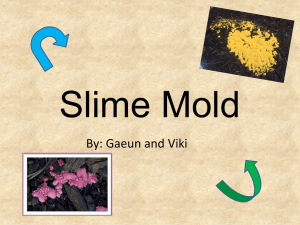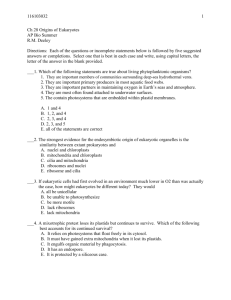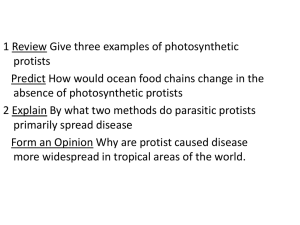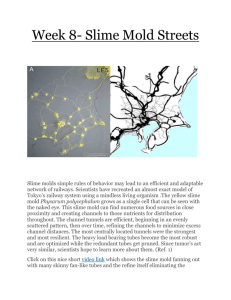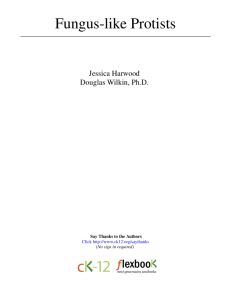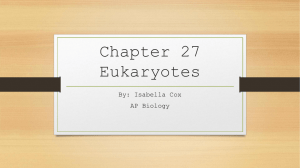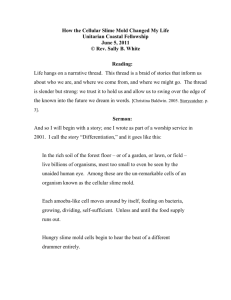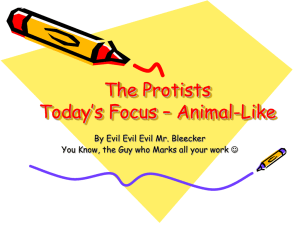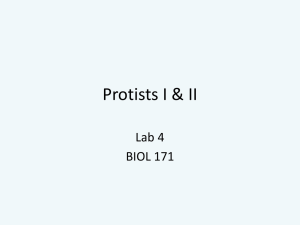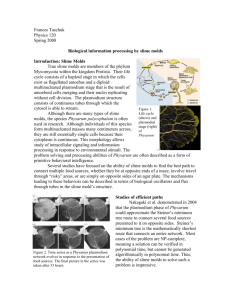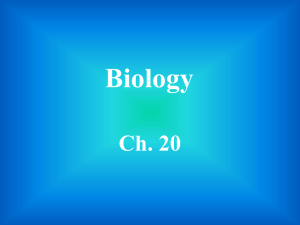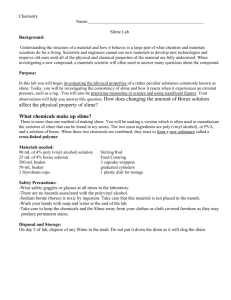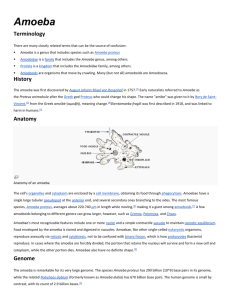File
advertisement
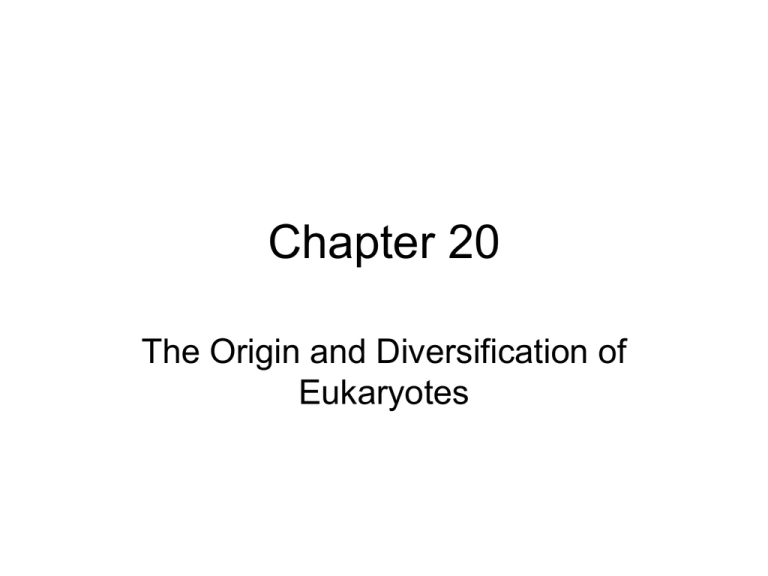
Chapter 20 The Origin and Diversification of Eukaryotes 20.1 Eukaryotes Acquired Features from Both Archaea and Bacteria • Eukaryotes that are not plants, animals, or fungi are called protists • Scientists believe came from the fusion of prokaryotes due to endosymbiosis Eukaryotes arose in several steps • The origin of a flexible cell surface • The origin of a cytoskeleton • The origin of a nuclear envelope • The appearance of digestive vacuoles • The acquisition of certain organelles via endosymbioisis http://learn.genetics.utah.edu/content/begin/cells/organelles/ Protista Video 20.2 Major Lineages of Eukaryotes Diversified in the Precambrian Characteristics of the Protists: • Range from unicelluar to multicellular • All are eukaryotic • Some free-living and some symbionts • Nearly all are aerobic • Some are photoautotrophs with chloroplasts; others are heterotrophs others combine photosynthesis and eating Characteristics of Protists (continued) • Most have cilia or flagella at some time in their life cycles • All can reproduce asexually; others can also reproduce sexually • Mitosis occurs in most • Some have elaborate cells even though unicellular; e.g., Paramecium Alveolates have sacs under their plasma membranes • Alveolates-possess sacs called alveoli under their membranes which play a role in supporting the cell surface • All are unicellular and most are photosynthetic • Dinoflagellates, Apicomplexans, and Ciliates Alveolates http://pinkava.asu.edu/starcentral/microscope/msr/rawdata/viewable/alveolates_1158459360__84w.jpg Dinoflagellates • Have protective cellulose plates • Most have two flagella—one in a longitudinal groove with distal end free and the other in a transverse groove that encircles the organism • Extremely numerous in the oceans • Most are heterotrophic Dinoflagellates continued • Some live as symbionts in invertebrates; e.g. coral • 2 genera cause “red tides” and produce a neurotoxin that can kill fish and paralytic shellfish poisoning in humans Figure 28.12 A dinoflagellate Figure 28.12x1 Dinoflagellate Figure 28.12x2 Swimming with bioluminescent dinoflagellates Apicomplexans • Derive there name from the apical complex which is a mass of organelles contained in the apical end (Helps invade host’s tissues) • Helps Plasmodium invade tissues to causes malaria • Plasmodium and Toxoplasma are parasites Apicomplexans Ciliates • Named for their hairlike cilia which a like flagella but shorter • Have two types of nuclei • Almost all are heterotrophic • Most common is the Paramecium Ciliates • Contractile Vacuole-A specialized vacuole that collects excess water taken in by osmosis, then contracts to expel the water from the cell • Digestive Vacuole-An organelle specialized for digesting food ingested by endocytosis Figure 28.14c Ciliates: Paramecium Figure 28.14x Ciliates: Stentor (left), Paramecium (right) Figure 28.15x Paramecium conjugating Paramecium Excavates began to diversify about 1.5 billion years ago • Lack mitochondria and lost them as they evolved • Shows eukaryotic life is possible without a mitochondria • Include: Diplomonads and Parabasalids, Heteroloboseans, and Euglenids and Kinetoplastids Excavates http://cnx.org/content/m44617/latest/Figure_23_03_02.jpg Diplomonads and Parabasalids • Unicellular and lack mitochondria • Causes contaminated water and diseases in humans Diplomonads and Parabasalids Heteroloboseans • Has an amoeboid body and can turn into a life cycle with a flagella http://pinkava.asu.edu/starcentral/microscope/msr/rawdata/files/trimastigamoeba_ihz.gif Euglenids and Kinetoplastids • Unicellular, freshwater organisms • Some have chloroplasts; the rest ingest food • If grown in darkness, lose chloroplasts and become heterotrophic • Have stored food in pyrenoid in form of a carbohydrate polymer paramylon • Bounded by a pellicle which is flexible to allow changes in shape Figure 28.03x Euglena Figure 28.3 Euglena: an example of a single–celled protist Figure 28.11x Trypanosoma, the kinetoplastid that causes sleeping sickness Stramenopiles typically have two unequal flagella, one with hairs • Include the diatoms and the brown algae which are photosynthetic • Also Oomycetes which are not http://cnx.org/content/m44617/latest/Figure_23_03_08.jpg Diatoms • Most numerous unicellular algae in oceans and are abundant in fresh water • Have cell walls of silica and many geometric shapes • Reproduce both sexually and asexually Figure 28.17 Diatoms: Diatom diversity (left), Pinnularia (left) Figure 28.17x Diatom shell Brown algae • Both brown and golden brown algae have chlorophylls a and c • Range from small forms with simple filaments to large multicellular forms we call seaweeds • Provide food and habitat for marine organisms and are harvested for human food and fertilizer Figure 28.1d Too diverse for one kingdom: Australian bull kelp (Durvillea potatorum) Figure 28.20x2 Kelp forest Figure 28.20x1 Kelp forest Water molds - oomycetes • Usually live in water and parasitize fish • Others live on land and parasitize insects and plants • One species caused Irish potato famine in 1840s • Have cell walls of cellulose; fungi have chitin • Saprobic-feed on dead organic matter Figure 28.16 The life cycle of a water mold (Layer 3) Figure 28.16x2 Water mold: Oogonium Figure 28.x2 Powdery mildew Rhizaria typically have long thin pseudopods • Include Cercozoans, Foraminiferans, and Radiolarians • Unicellular and mostly aquatic • Pseudopods allow for movement Cercozoans • Very diverse group with many forms and habitats https://ncma.bigelow.org/media/catalog/category/cercozoa.png Foraminiferans • Secrete external shells of calcium carbonate • Some live as plankton and others live on the seas floor • Form much of the world’s limestone http://gallery.usgs.gov/images/03_27_2014/gkb4Frq11X_03_27_2014/large/Animals_SignsStructuresEtc_Structures_00047.jpg Figure 28.28 Foraminiferan Radiolarians • Have thin pseudopods which are structured with microtubules • Help them stay afloat in the ocean • Well know for when they shed their endoskeletons http://micro.magnet.fsu.edu/micro/gallery/radiolarians/radiohead.jpg Figure 28.27x Radiolarian skeleton Figure 28.27 Actinopods: Heliozoan (left), radiolarian (right) Amoebozoans use lobe-shaped pseudopods for locomotion • Three groups loboseans, plasmodial slime molds and cellular slime molds http://upload.wikimedia.org/wikipedia/commons/b/b3/Chaos_carolinense.jpg Loboseans • Small Amoebozoans that feed by phagocytosis engulfing with the pseudopod • Live in the bottom of lakes and ponds • Most are predators, parasites, or scavengers Figure 28.1a Too diverse for one kingdom: Amoeba proteus, a unicellular "protozoan" Figure 28.26 Use of pseudopodia for feeding Plasmodial (acellular) Slime Molds • Consist of a multinucleated mass, a plasmodium • Phagocytizes decaying plant material • Develops sporangia during unfavorable conditions • Coenocyte-many nuclei enclosed in a single plasma membrane Figure 28.29x1 Plasmodial slime mold Figure 28.1c Too diverse for one kingdom: a slime mold (Physarum polychalum) Figure 28.29 The life cycle of a plasmodial slime mold, such as Physarum Figure 28.29x2 Slime mold Sporangia Cellular Slime Molds • Consist of individual ameboid cells • During unfavorable conditions cells aggregate into pseudoplasmodium • Sporangium produces spores that release haploid ameboid cells Figure 28.30 The life cycle of a cellular slime mold (Dictyostelium) Figure 28.30x1 Dictyostelium life cycle Slime Mold Video • The difference between Plasmodial or acellular slime molds and cellular slime molds is that cellular slime molds have separated nuclei. Plasmodial slime molds create a mass with multiple nuclei 20.3 Protists reproduce sexually and asexually • Protists produce asexually by: – Binary fission-one cell into two – Multiple fission- one cell into multiple – Budding-outgrowth of a new cell from a previous one – Sporulation-formation of a spore that is able to grow into a new organism • Clonal lineages-Asexually reproduced groups of nearly identical organisms Some protists reproduce without sexual reproduction • Parmecia go through the process of conjugation • This is when two individuals line up tightly against each other and fuse • Genetic material is exchanged creating a micronucleus • Meiosis and mitosis also take place • Not a form of reproduction just a sexual process of genetic recombination Figure 28.15x Paramecium conjugating Some protist life cycles feature alternation of generations • Alternation of generations-The succession of multicellular haploid and diploid phases in some sexually reproducing organisms • The haploid organism, the diploid organism, or both may also reproduce asexually • Morphology may or not different in alternation of generations • Heteromorphic-the two generations differ morphologically • Isomorphic-they do not differ http://www.quia.com/files/quia/users/lmcgee/protistpictures/AP_Chpt_28_Protists/Alternation-of-generations-.gif • The gamete producing generation does not produce gametes by meiosis because it is haploid • Specialized cells of the diploid sporeproducing organism, called sporocytes, divide meiotically to produce four haploid spores • Gametes can only produce new organisms by fusing with other gametes http://plantphys.info/organismal/lechtml/images/achlyaoogonia.jpg 20.4 Protists Are Critical Components of Many Ecosystems http://aquabella4aquariums.com/blog/wp-content/uploads/2013/06/ecosystem101.png Phytoplankton are primary producers http://w3.shorecrest.org/~Lisa_Peck/MarineBio/syllabus/ch11_ecosystems/ecosystem_wp/neriticzone_jonathan_wade/energy_pyramid.gif Some microbial eukaryotes are deadly http://4.bp.blogspot.com/-R-dhf4iQooU/UguBWA19wVI/AAAAAAAABS4/YaR6AYejpy4/s1600/ANOPHELES+MOSQUITOES.jpg Some microbial eukaryotes are endosymbionts Coral Bleaching (Protists dying) http://media.treehugger.com/assets/images/2011/10/bleached-coral-photo-0001.jpg We rely on the remains of ancient marine protists http://www.agiweb.org/education/energy/images/gasformation.png
